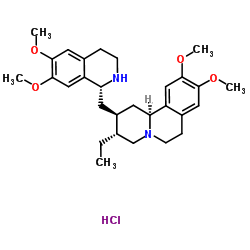Emetine hydrochloride
Modify Date: 2025-08-23 13:10:09

Emetine hydrochloride structure
|
Common Name | Emetine hydrochloride | ||
|---|---|---|---|---|
| CAS Number | 14198-59-5 | Molecular Weight | 517.100 | |
| Density | 1.17g/cm3 | Boiling Point | 624.8ºC at 760 mmHg | |
| Molecular Formula | C29H41ClN2O4 | Melting Point | N/A | |
| MSDS | N/A | Flash Point | 331.7ºC | |
Use of Emetine hydrochlorideEmetine hydrochloride, derived from the ipecac root, is a potent anti-protozoal and emetic agent. Emetine hydrochloride inhibits viral polymerases and inhibits Zika and Ebola virus infections. Emetine hydrochloride potently inhibits autophagy and has anti-malarial, anti-bacterial and anti-amoebic effect[1][2][3][4]. |
| Name | (2S,3R,11bS)-2-[[(1R)-6,7-dimethoxy-1,2,3,4-tetrahydroisoquinolin-1-yl]methyl]-3-ethyl-9,10-dimethoxy-2,3,4,6,7,11b-hexahydro-1H-benzo[a]quinolizine,hydrochloride |
|---|---|
| Synonym | More Synonyms |
| Description | Emetine hydrochloride, derived from the ipecac root, is a potent anti-protozoal and emetic agent. Emetine hydrochloride inhibits viral polymerases and inhibits Zika and Ebola virus infections. Emetine hydrochloride potently inhibits autophagy and has anti-malarial, anti-bacterial and anti-amoebic effect[1][2][3][4]. |
|---|---|
| Related Catalog | |
| In Vitro | Emetine hydrochloride accumulates SQSTM1 and MAP1LC3B in SNB-19 cells, indicating autophagy is blocked[1]. Emetine hydrochloride dose-dependently decreases NS1 protein level in HEK293 cells infected with the African prototype, ZIKV MR766 (IC50=52.9 nM). Emetine hydrochloride directly inhibits ZIKV NS5 RNA polymerase activity with an IC50 of 121 nM[1]. Cell Autophagy Assay[1] Cell Line: SNB-19 cells Concentration: 25, 50, 100, 200 nM Incubation Time: For 24 hours Result: Showed the accumulation of SQSTM1 and MAP1LC3B, indicating autophagy was blocked. |
| In Vivo | Emetine hydrochloride (1, 2 mg/kg/day; IP; for 3 days) significantly reduces the serum viral load of ZIKV infected Ifnar1−/− mice[1]. Emetine hydrochloride (1 mg/kg/day; retro-orbital injection; for six days) reduces the levels of circulating ZIKV approximately 10-fold in three-month-old female SJL mice with ZIKVBR[1]. Emetine (0.002, 0.02, 0.2, 2 mg/kg/day; i.p.) not only attenuates blood glucose levels in dose-dependent way but also induces a persistent attenuation of blood glucose levels in C57Bl/6 male mice (20-25 g) [2]. Animal Model: Ifnar1−/− mice[1] Dosage: 1, 2 mg/kg Administration: IP; once daily for 3 days Result: Significantly reduced the serum viral load of ZIKV infected Ifnar1−/− mice. |
| References |
| Density | 1.17g/cm3 |
|---|---|
| Boiling Point | 624.8ºC at 760 mmHg |
| Molecular Formula | C29H41ClN2O4 |
| Molecular Weight | 517.100 |
| Flash Point | 331.7ºC |
| Exact Mass | 516.275513 |
| PSA | 52.19000 |
| LogP | 6.01210 |
| Vapour Pressure | 4.54E-16mmHg at 25°C |
| InChIKey | HUEYSSLYFJVUIS-MRFSYGAJSA-N |
| SMILES | CCC1CN2CCc3cc(OC)c(OC)cc3C2CC1CC1NCCc2cc(OC)c(OC)cc21.Cl |
| (-)-Emetine hydrochloride |
| Cephaeline methyl ether HCl |
| 6',7',10,11-Tetramethoxyemetan hydrochloride (1:1) |
| Cephaeline methyl ether hydrochloride |
| Emetin-hydrochlorid |
| EMETINE HYDROCHLORIDE |
| 2H-Benzo[a]quinolizine, 3-ethyl-1,3,4,6,7,11b-hexahydro-9,10-dimethoxy-2-[[(1R)-1,2,3,4-tetrahydro-6,7-dimethoxy-1-isoquinolinyl]methyl]-, (2S,3R,11bS)-, hydrochloride (1:1) |
| Emetine monohydrochloride |
| Emetan, 6',7',10,11-tetramethoxy-, monohydrochloride |
| emetine chloride |